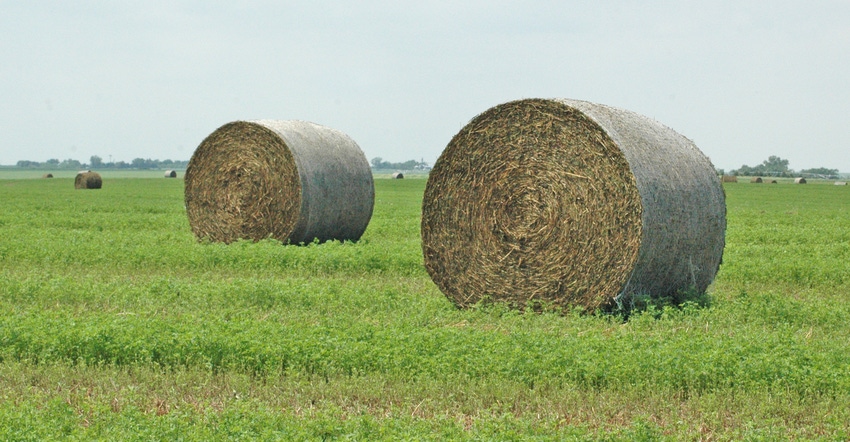Studies show feed spoilage and waste not only costs money but also impacts cattle health.
March 10, 2021

Feed spoilage and waste obviously costs money, but it may have bigger impacts on cattle health as well. Iowa State University Extension beef specialist Denise Schwab offers these reminders of feed loss types, causes and effects, and how to address possible challenges:
Storage and feeding losses. Hay storage losses for big round bales stored on the ground and uncovered range from 5% to 61%, while bales stored on a well-drained base and covered with plastic or a tarp are only 2% to 17%.
Feeder style also impacts losses. A Michigan study showed that ring feeders with an elevated center cone resulted in 3.5% feeding loss, while stationary cradle feeders had 14.6% waste. However, feeding on the ground without any feeder typically ranges from 20% to 30% loss.
A Wisconsin study compared various losses in silage, considering filling, seepage, gas, surface and feedout losses. Oxygen-limiting towers and silage bags showed the lowest losses in the 6% to 13% or 9% to 17% ranges. Uncovered stacks or bunkers were the highest with losses in the 34% to 58% and 24% to 43% ranges, with both having the highest losses from gas and surface. Also noted, feedout loss is 3% to 5% with good management on concrete floors, but 8% to 20% with earthen floor and good face management. With less than good management, as much as an additional 7% loss can be expected.
Both storage and feeding losses add to increased feed costs for the cow herd. For a cow provided 40 pounds of hay at $120 per ton with 10% waste, that equals $7.20 per cow per month in feed loss. For $45 per ton silage, 10% feed loss at 50 pounds silage consumption is $3.37 per cow per month in feed loss.
Waste in mud. The effect of mud on energy requirements of the cow is obvious, but muddy conditions also have a direct impact on feed loss from both the feed storage area and the animal feeding area. Mud often includes manure, leading to a vector for diseases such as clostridium. Contamination will lead to immediate feed refusal. Soiled feed also creates a concern for curious calves.
Reducing mud and soil contamination is important, along with ease of storing and feeding. The best silage and hay storage option is on concrete to reduce problems at harvest and feedout. When concrete pads are not an option, choose a site that is high and dry, and consider adding rock or limestone to make a more solid base with good drainage.
Avoid low areas that result in muddy messes when feeding out the silage or forage. Feed in contact with wet or muddy conditions deteriorates, resulting in loss of feed quality and quantity. Mud also increases forage’s ash content and, particularly, iron content of soil-contaminated feed.
Feeding locations. Carefully consider feeding locations to reduce feed waste and contamination. While winter feeding of hay or silage on frozen ground may work for many producers, an alternative is needed when ground is not frozen. Bunks or tires work well, but a solid base beneath is needed for both the equipment to deliver the feed as well as for the cows to access the feeder. In frozen conditions, some of the dropped feed can still be consumed by the cow, but in muddy conditions any dropped feed is wasted.
Adequate bunk space for all cows also is important to reduce the amount of feed waste due to aggression for access to feed.
Iron issues. Soil-contaminated feed, either from harvesting or at feedout, results in increased ash content. While ash level alone is not critical, it is an indicator of increased levels of iron and other minerals. The average ash content in forages is normally 4% to 5% in corn silage, 6% to 7% in corn stover, 6% to 8% in grasses and 8% to 10% in legumes.
Weather-damaged forages are typically higher in ash from soil contact at harvest. Drought, floods and the recent derecho all can increase the ash content of the 2020 forages. Harvest practices such as low cutting height, low rake setting and mergers also can increase the soil contamination on forages. Hay stored on wet or muddy ground, silage piled directly on the ground and muddy conditions at feedout also increase soil contamination.
When high levels of ash content are found in forages, minerals begin to compete with other minerals for absorption within the cow. Soil is often high in iron, which causes a decrease in manganese absorption. Because manganese is important in bone and cartilage development in a fetus, manganese deficiency can lead to increased risk for the birth defect called chondrodysplasia.
In many Iowa herds, potential high-iron feeds such as soil-contaminated corn silage are fed at greatest concentrations during the third trimester of gestation in spring calving cows. This is also a time when producers aren’t as consistent with mineral delivery.
Stephanie Hansen, Iowa State University animal science professor and beef nutritionist, explains how soil-contaminated silage may lead to manganese-deficiency birth defects in the December 2020 Growing Beef newsletter.
Cattle producers who experience a calf born with the symptoms of chondrodysplasia such as dwarf appearance, shortened bone growth or a prominent lower jaw due to undeveloped nasal cartilage, should work with their vet to determine the cause.
Source: Iowa Beef Center, which is responsible for the information provided and is wholly owned by the source. Informa Business Media and its subsidiaries aren't responsible for any of the content contained in this information asset.
You May Also Like



